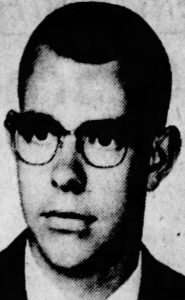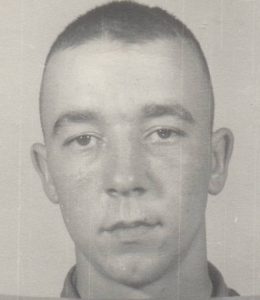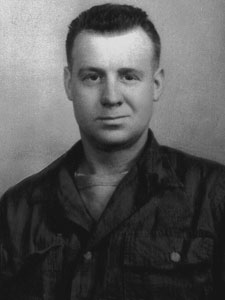Howard Gerald Brewer, age 20, from Saint Clair County Port Huron, Michigan .
Parents: Rose Fretenborough and Howard G. Brewer Sr. His last letter dated Nov. 22, 1950 to his mother: “Don’tworry about me, I’ll take care of myself.”
Service era: Korea
Date of death: Thursday, November 30, 1950
Death details: By mid-November 1950, U.S. and Allied forces had advanced to within approximately sixty miles of the Yalu River, the border between North Korea and China. On November 25, approximately 300,000 Chinese Communist Forces (CCF) “volunteers” suddenly and fiercely counterattacked after crossing the Yalu. The 2nd Infantry Division, located the farthest north of units at the Chongchon River, could not halt the CCF advance and was ordered to withdraw to defensive positions at Sunchon in the South Pyongan province of North Korea. As the division pulled back from Kunu-ri toward Sunchon, it conducted an intense rearguard action while fighting to break through well-defended roadblocks set up by CCF infiltrators. The withdrawal was not complete until December 1, and the 2nd Infantry Division suffered extremely heavy casualties in the process. Corporal Howard Gerald Brewer, who joined the U.S. Army from Michigan, was a member of H Company, 2nd Battalion, 38th Infantry Regiment, 2nd Infantry Division. On November 29, 1950, the 38th Infantry Regiment was ordered to defend the area east of Kunu-ri, to cover the start of the 2nd Division’s retreat. The CCF attacked as the 38th Infantry consolidated their defenses, forcing the defenders to fight their way back to Kunu-ri before joining the withdrawal to Sunchon. A series of intense moving battles ensued, and CPL Brewer was killed at some point during the fighting. His remains could not be recovered at the time due to the chaotic nature of the withdrawal, and the area never returned to Allied control. He could not be associated with any remains returned to U.S. control following the end of hostilities. Today, Corporal Brewer is memorialized on the Courts of the Missing at the National Memorial Cemetery of the Pacific. His name is also inscribed on the Korean War Veterans Memorial Wall in Washington, DC, which was updated in 2022 to include the names of the fallen.
Source: National Archives, Defense POW/MIA Accounting Agency, Times Herald (1950)


 Death details: In late March 1953, elements of the 1st Marine Division manned a string of outposts along a 33-mile section of the main line of resistance on the Korean Peninsula, near the present-day Demilitarized Zone (DMZ). The 1st Marine Division’s 5th Marine Regiment was responsible for three of these outposts, named Carson, Reno, and Vegas, or collectively “the Nevada Cities Complex.” On March 26, Chinese Communist Forces attacked all three outposts. Although Carson managed to stave off the assault, Reno and Vegas, which were more lightly manned, eventually succumbed to the enemy. Over 1,000 Marines were killed, wounded, or went missing during the attack on the Nevada Cities Complex. Corporal Earl William Tucker Jr. joined the U.S. Marine Corps from Michigan and was a member of the Weapons Company, 3rd Battalion, 5th Marine Regiment, 1st Marine Division. He went missing in action during the fighting at the Nevada Cities Complex on March 26, 1953. He was never reported to be a prisoner of war, and he was not identified among remains returned to U.S. custody after the conflict’s ceasefire. Today, Corporal Tucker is memorialized on the Courts of the Missing at the National Memorial Cemetery of the Pacific.
Death details: In late March 1953, elements of the 1st Marine Division manned a string of outposts along a 33-mile section of the main line of resistance on the Korean Peninsula, near the present-day Demilitarized Zone (DMZ). The 1st Marine Division’s 5th Marine Regiment was responsible for three of these outposts, named Carson, Reno, and Vegas, or collectively “the Nevada Cities Complex.” On March 26, Chinese Communist Forces attacked all three outposts. Although Carson managed to stave off the assault, Reno and Vegas, which were more lightly manned, eventually succumbed to the enemy. Over 1,000 Marines were killed, wounded, or went missing during the attack on the Nevada Cities Complex. Corporal Earl William Tucker Jr. joined the U.S. Marine Corps from Michigan and was a member of the Weapons Company, 3rd Battalion, 5th Marine Regiment, 1st Marine Division. He went missing in action during the fighting at the Nevada Cities Complex on March 26, 1953. He was never reported to be a prisoner of war, and he was not identified among remains returned to U.S. custody after the conflict’s ceasefire. Today, Corporal Tucker is memorialized on the Courts of the Missing at the National Memorial Cemetery of the Pacific.